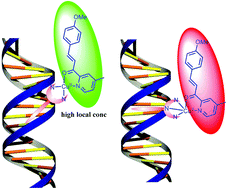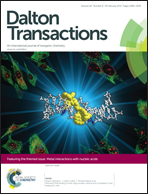Characterisation of the interactions between substrate, copper(ii) complex and DNA and their role in rate acceleration in DNA-based asymmetric catalysis†
Abstract
Interactions of the azachalcone derived substrate Aza with copper(II) complexes in the presence and absence of st-DNA were studied in detail by UV/Vis absorption, EPR and Raman and (UV and vis) resonance Raman spectroscopies. The binding of Aza to the Lewis acidic copper(II) complexes, which results in activation of the substrate, was established spectroscopically. It was shown that the binding of Aza differs between CuIIdmbpy and CuIIterpy, consistent with the observed differences in catalytic asymmetric Diels–Alder reactions with regard to both the rate and enantiomeric preference. Finally, it was shown that DNA has a major beneficial effect on the binding of Aza to the copper(II) complex due to the fact that both bind to the DNA. The result is a high effective molarity of both the copper complexes and the Aza substrate, which leads to a significant increase in binding of Aza to the copper(II) complex. This effect is a key reason for the observed rate acceleration in the catalyzed reactions brought about by the presence of DNA.

- This article is part of the themed collection: Metal Interactions with Nucleic Acids

 Please wait while we load your content...
Please wait while we load your content...